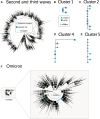Integrated Genomic and Social Network Analyses of SARS-CoV-2 Transmission in the Healthcare Setting
- PMID: 38227643
- PMCID: PMC11093679
- DOI: 10.1093/cid/ciad738
Integrated Genomic and Social Network Analyses of SARS-CoV-2 Transmission in the Healthcare Setting
Abstract
Background: Infection prevention (IP) measures are designed to mitigate the transmission of pathogens in healthcare. Using large-scale viral genomic and social network analyses, we determined if IP measures used during the severe acute respiratory syndrome coronavirus 2 (SARS-CoV-2) pandemic were adequate in protecting healthcare workers (HCWs) and patients from acquiring SARS-CoV-2.
Methods: We performed retrospective cross-sectional analyses of viral genomics from all available SARS-CoV-2 viral samples collected at UC San Diego Health and social network analysis using the electronic medical record to derive temporospatial overlap of infections among related viromes and supplemented with contact tracing data. The outcome measure was any instance of healthcare transmission, defined as cases with closely related viral genomes and epidemiological connection within the healthcare setting during the infection window. Between November 2020 through January 2022, 12 933 viral genomes were obtained from 35 666 patients and HCWs.
Results: Among 5112 SARS-CoV-2 viral samples sequenced from the second and third waves of SARS-CoV-2 (pre-Omicron), 291 pairs were derived from persons with a plausible healthcare overlap. Of these, 34 pairs (12%) were phylogenetically linked: 19 attributable to household and 14 to healthcare transmission. During the Omicron wave, 2106 contact pairs among 7821 sequences resulted in 120 (6%) related pairs among 32 clusters, of which 10 were consistent with healthcare transmission. Transmission was more likely to occur in shared spaces in the older hospital compared with the newer hospital (2.54 vs 0.63 transmission events per 1000 admissions, P < .001).
Conclusions: IP strategies were effective at identifying and preventing healthcare SARS-CoV-2 transmission.
Keywords: SARS-CoV-2 pandemic; healthcare transmission of SARS-CoV-2; infection prevention precautions; social network analyses and contact tracing; whole-genome sequencing.
© The Author(s) 2024. Published by Oxford University Press on behalf of Infectious Diseases Society of America. All rights reserved. For permissions, please e-mail: journals.permissions@oup.com.
Conflict of interest statement
Potential conflicts of interest. K. G. A. reports consulting fees from Adagio Therapeutics (consulting and Scientific Advisory Board (SAB)) and Ring Therapeutics (consulting); a role of SAB for Adagio Therapeutics; stock or stock options with Ring Therapeutics; and grants or contracts from National National Center for Advancing Translational Sciences, NIAID, Prebys 211—Prebys Foundation, Bill & Melinda Gates Foundation, 2016 Pew Scholar—Pew Charitable Trust, National Institute of General Medical Sciences, and CDC. C. A. L. reports serving as equity holder and advisor (unrelated to this work) for Doximity. L. E. H. reports consulting fees from Gilead; payment or honoraria for lectures, presentations, speakers bureaus, manuscript writing, or educational events from AstraZeneca, the Infectious Diseases Association of California, the Medical Education Speakers Network, and CME consultants; support for attending meetings and/or travel from AstraZeneca; stock or stock options from Pfizer; and is a salaried employee of Pfizer. S. B. reports an NIH and an unrestricted departmental grant from Research to Prevent Blindness (no role in design of the study and no payment) and receipt of equipment, materials, drugs, medical writing, gifts, or other services from Optomed and Topcon. L. C. L. reports stock or stock options from Illumina, Inc and equipment and reagents for sequencing purchased from Illumina via UCSD Institute for Genomic Medicine. R. K. reports consulting fees from DayTwo (consultant and SAB member), Cybele (stock and consultant), and Biomesense (stock, consultant, SAB member); participation on a data safety monitoring board or advisory board from Gencirq (stock and SAB member) and Micronoma (stock, SAB member, and cofounder); and owning stock and serving as cofounder of Biota. J. O. W. reports grants or contracts to their institution from the CDC and consulting fees as an expert witness (consulting fees paid to author) from Charles Russell Speechlys, LLP. All other authors report no potential conflicts. All authors have submitted the ICMJE Form for Disclosure of Potential Conflicts of Interest. Conflicts that the editors consider relevant to the content of the manuscript have been disclosed.
Figures




References
-
- Spencer J, Jewett C. Lost on the frontline: our key findings about US healthcare worker deaths to date. Guardian 2021. Available at: https://www.theguardian.com/us-news/2021/apr/08/us-health-workers-deaths.... Accessed December 2023.

